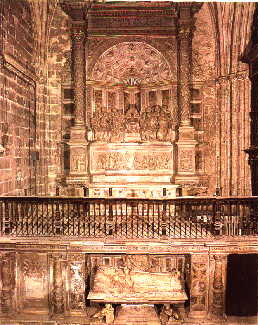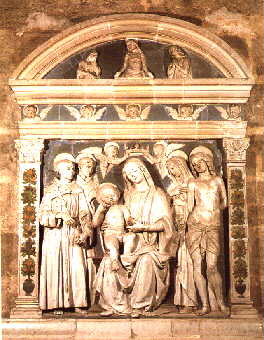Seville Cathedral: Chapel of Scalas
 Reredos of the Chapel of Scalas
Reredos of the Chapel of Scalas |
Originally this chapel was consecrated to Nuestra Señora de la Consolación and to the Twelve Apostles, but it is commomly called Scalas because it was founded by Don Baltasar del Rio, the bishop of Scalas, who was also an archdeacon of Niebla and a canon of Seville Cathedral.
In 1521 the bishop decided to build an altar and to place his sepulchre at its foot, which was done without delay.
He died, however, in 1541 and was buried in the Church of Santiago de los Españoles in Rome, which is why his remains are not found in his Seville sepulchre.
|
The chapel is closed off by a magnificent Renaissance screen dating from 1564.
Above the screen there is a Gothic stained-glass window depicting four apostles who can be identified as St Judas Tadeo, St James the Less, St Philip and St James the Greater by Enrique Alemán who began them in 1475.
The stained-glass window illuminating the inside of the chapel dates from the 19C and was made in Munich in 1880.
It shows The Coming of the Holy Spirit and includes the praying figures of the two priests who paid for it: the Precentor Don Cayetano Fernández and the Archpriest Don Jeronimo Alvarez Troya.
|
 Virgin of La Granada
Virgin of La Granada
|
In the lower front part of the chapel there is the sepulchre of Don Baltasar del Río with his reclining figure upon the sarcophagus.
In the back of the recess with the sarcophagus there is a medallion with a relief of The Virgin with Child, and the sculptures of St Peter and St Paul.
Above the sepulchre there is a tribune with a magnificent marble reredos on top, framed by Corinthian columns topped by a frieze with the corresponding cornice.
The whole structure is crowned by a curved frontal with a relief of The Heavenly Father.
The centre of the reredos has a large relief of The Coming of the Holy Spirit.
The centre of the predella is occupied by a relief of The Miracle of the Loaves and the Fishes, while the praying bischop and his coat of arms are found on the sides.
This reredos is ascribed to the workshop of the Gazini de Bisones and it must have been built a little before 1539, the year in which it was put in the chapel.
|
Another important work of art adorns this chapel: the glazed terracotta relief called La Virgen de Granada, which shows The Virgin with Child in the company of the St Sebastian, St Francis, Santa Casilda and St Dominic.
The top of this relief is a curved frontal with a figure of Christ Man of Sorrow in the arch bay, accompanied by the Virgin and St John.
This magnificent work of art is related to the Florentine artist Andrea della Robbia and dates from the 15C.
Several paintings adorn the chapel, those of St Ignatius and The Compassion of St Thomas being of little interest.
Both are by anonymous artisti of the 17C.
An anonymous disciple of Murillo painted San Fernando around 1675, while Francisco Antolínez painted The Adoration of the Shephers in 1678.
Juan Ruiz Soriano`s The Holy Family in the style of Murillo dates from 1740, while The Beheading of John the Baptist is by an anonymous follower of Rubens, dating from the middle of the 17C.
|
|
|



